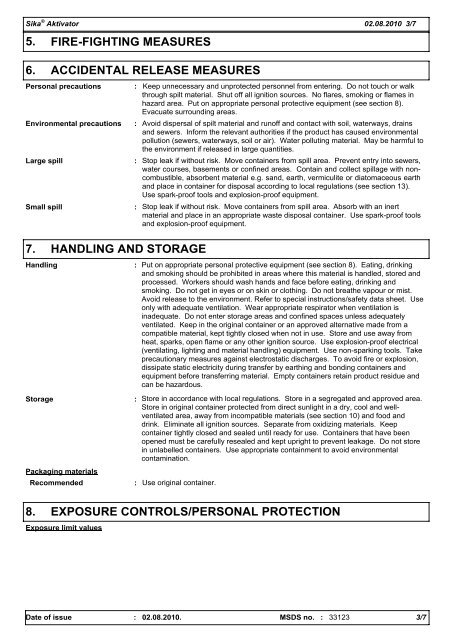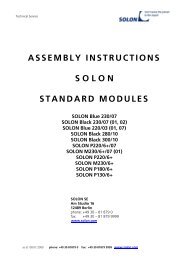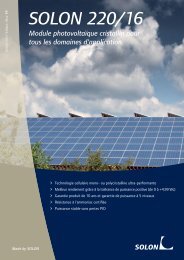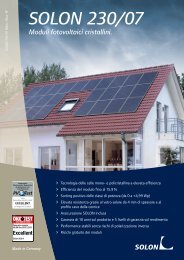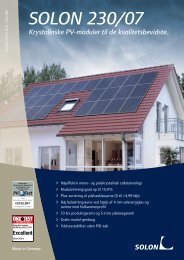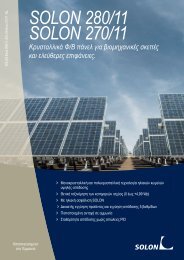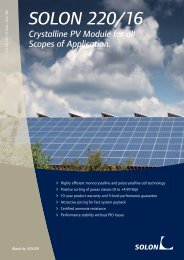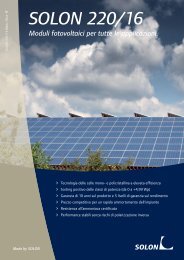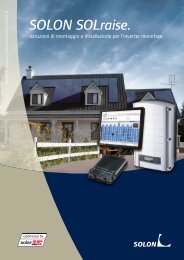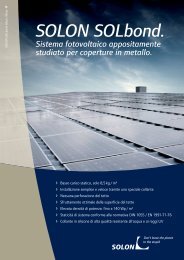SOLON SOLbond Seam.
SOLON SOLbond Seam.
SOLON SOLbond Seam.
You also want an ePaper? Increase the reach of your titles
YUMPU automatically turns print PDFs into web optimized ePapers that Google loves.
Sika ® Aktivator 02.08.2010 3/7<br />
5. FIRE-FIGHTING MEASURES<br />
6. ACCIDENTAL RELEASE MEASURES<br />
Personal precautions : Keep unnecessary and unprotected personnel from entering. Do not touch or walk<br />
through spilt material. Shut off all ignition sources. No flares, smoking or flames in<br />
hazard area. Put on appropriate personal protective equipment (see section 8).<br />
Evacuate surrounding areas.<br />
Environmental precautions : Avoid dispersal of spilt material and runoff and contact with soil, waterways, drains<br />
and sewers. Inform the relevant authorities if the product has caused environmental<br />
pollution (sewers, waterways, soil or air). Water polluting material. May be harmful to<br />
the environment if released in large quantities.<br />
Large spill :<br />
Small spill :<br />
7. HANDLING AND STORAGE<br />
Stop leak if without risk. Move containers from spill area. Prevent entry into sewers,<br />
water courses, basements or confined areas. Contain and collect spillage with noncombustible,<br />
absorbent material e.g. sand, earth, vermiculite or diatomaceous earth<br />
and place in container for disposal according to local regulations (see section 13).<br />
Use spark-proof tools and explosion-proof equipment.<br />
Stop leak if without risk. Move containers from spill area. Absorb with an inert<br />
material and place in an appropriate waste disposal container. Use spark-proof tools<br />
and explosion-proof equipment.<br />
Handling : Put on appropriate personal protective equipment (see section 8). Eating, drinking<br />
and smoking should be prohibited in areas where this material is handled, stored and<br />
processed. Workers should wash hands and face before eating, drinking and<br />
smoking. Do not get in eyes or on skin or clothing. Do not breathe vapour or mist.<br />
Avoid release to the environment. Refer to special instructions/safety data sheet. Use<br />
only with adequate ventilation. Wear appropriate respirator when ventilation is<br />
inadequate. Do not enter storage areas and confined spaces unless adequately<br />
ventilated. Keep in the original container or an approved alternative made from a<br />
compatible material, kept tightly closed when not in use. Store and use away from<br />
heat, sparks, open flame or any other ignition source. Use explosion-proof electrical<br />
(ventilating, lighting and material handling) equipment. Use non-sparking tools. Take<br />
precautionary measures against electrostatic discharges. To avoid fire or explosion,<br />
dissipate static electricity during transfer by earthing and bonding containers and<br />
equipment before transferring material. Empty containers retain product residue and<br />
can be hazardous.<br />
Storage :<br />
Packaging materials<br />
Recommended : Use original container.<br />
Exposure limit values<br />
Store in accordance with local regulations. Store in a segregated and approved area.<br />
Store in original container protected from direct sunlight in a dry, cool and wellventilated<br />
area, away from incompatible materials (see section 10) and food and<br />
drink. Eliminate all ignition sources. Separate from oxidizing materials. Keep<br />
container tightly closed and sealed until ready for use. Containers that have been<br />
opened must be carefully resealed and kept upright to prevent leakage. Do not store<br />
in unlabelled containers. Use appropriate containment to avoid environmental<br />
contamination.<br />
8. EXPOSURE CONTROLS/PERSONAL PROTECTION<br />
Date of issue : 02.08.2010. MSDS no. : 33123 3/7


